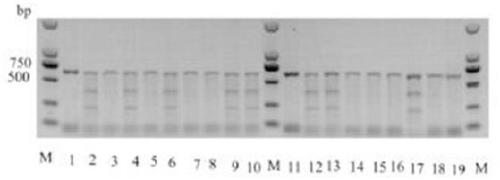Method for obtaining lymphoma minipig disease model by knocking out p53 gene
A disease model, a technology of miniature pigs, applied in the field of medical animal disease models, can solve the problems of high cost of treatment, cell growth arrest, small size of miniature pigs, etc., and achieve the effects of easy promotion and use, high controllability, and no harm.
- Summary
- Abstract
- Description
- Claims
- Application Information
AI Technical Summary
Problems solved by technology
Method used
Image
Examples
Embodiment 1
[0075] The specific steps of the method for obtaining the lymphoma minipig disease model by knocking out the P53 gene are as follows:
[0076] The first step, the design, assembly and extracellular activity detection of P53 gene knockout TALEN plasmid pair
[0077] 1) Design the TALEN target in the fourth exon region according to the porcine P53 gene sequence on NCBI;
[0078] 2) Assemble the TALEN plasmids pCAG-pP53-L and pCAG-pP53-R, for the left TALEN recognition sequence: TCTGGAACAGCCAAGT, the RVD sequence is as follows: NG HD NG NN NN NI NI HD NI NN HD HD NI NI NN NG; for the right TALEN recognition Sequence: CCCTCAAGGCCACTGAC, the RVD sequence is as follows: HD HD HD NG HD NI NI NNNN HD HD NI HD NG NN NI HD, respectively assembled into plasmids pCAG-pP53-L and pCAG-pP53-R according to the left and right RVD sequences;
[0079] 3) Detection of extracellular activity of TALEN plasmid pair, a terminator is in the center of the coding region of luciferase, luciferase has no...
Embodiment 2
[0102] The specific steps of the method for obtaining the lymphoma minipig disease model by knocking out the P53 gene are as follows:
[0103] The first step, the design, assembly and extracellular activity detection of P53 gene knockout TALEN plasmid pair
[0104] 1) According to the porcine P53 gene sequence on NCBI, design the TALEN target in the fourth exon region. The target sequence is:
[0105] TCTGGAACAGCCAAGTCTGTAACCTGCACGGTCAGTGGCCTTGAGGG;
[0106] 2) Assemble the TALEN plasmids pCAG-pP53-L and pCAG-pP53-R, for the left TALEN recognition sequence: TCTGGAACAGCCAAGT, the RVD sequence is as follows: NG HD NG NN NN NI NI HD NI NN HD HD NI NI NN NG; for the right TALEN recognition Sequence: CCCTCAAGGCCACTGAC, the RVD sequence is as follows: HD HD HD NG HD NI NI NNNN HD HD NI HD NG NN NI HD, respectively assembled into plasmids pCAG-pP53-L and pCAG-pP53-R according to the left and right RVD sequences;
[0107] 3) Detection of extracellular activity of TALEN plasmid pair,...
PUM
 Login to View More
Login to View More Abstract
Description
Claims
Application Information
 Login to View More
Login to View More - R&D
- Intellectual Property
- Life Sciences
- Materials
- Tech Scout
- Unparalleled Data Quality
- Higher Quality Content
- 60% Fewer Hallucinations
Browse by: Latest US Patents, China's latest patents, Technical Efficacy Thesaurus, Application Domain, Technology Topic, Popular Technical Reports.
© 2025 PatSnap. All rights reserved.Legal|Privacy policy|Modern Slavery Act Transparency Statement|Sitemap|About US| Contact US: help@patsnap.com



